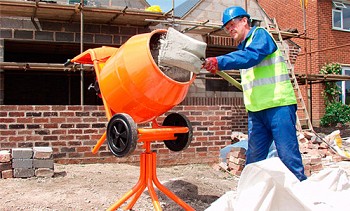What is a semi-dry floor screed, its pros and cons
Semi-dry screed, as usual, is used to level the rough floor for various coatings or to use it as an industrial floor after grinding and painting with special paints on concrete. The changes concern only the installation technology, which is caused by some innovations introduced in the traditional solution formula.
Compared with the usual method of pouring concrete or cement-sand mixture, the semi-dry method has several advantages, but it is not without its drawbacks. You will learn about all the pros and cons of a semi-dry floor screed by reading the article below. In the analysis, it may seem that the shortcomings of a semi-dry floor screed are very significant, but if this were so, then it would not be so widespread, especially in industrial construction.
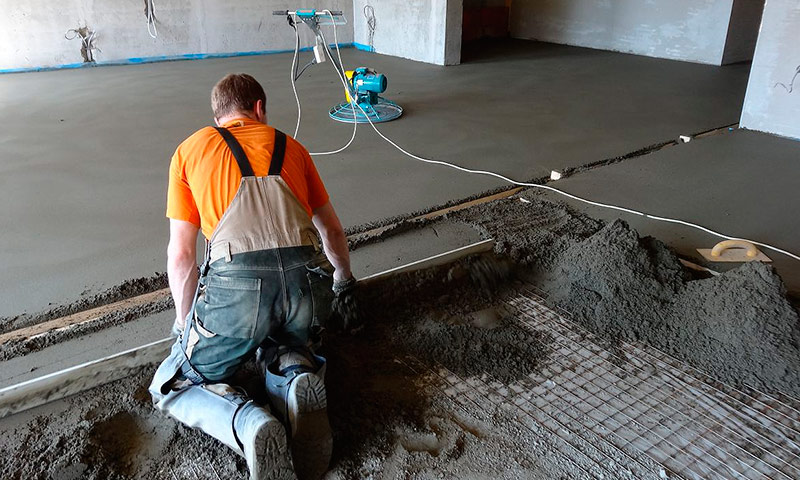
Content:
What is a semi-dry screed and what materials are used for its manufacture
Among all types of screeds, semi-dry takes an intermediate position between normal (wet) and less common dry. It differs from the usual screed with a lower water content in the finished solution. The remaining components - cement and sand, are used in the usual proportions and the strength of the semi-dry mixture after solidification practically does not differ.
Standard types of semi-dry screeds include:

Cement brand M500.

Coarse sand with fractions of at least 0.25 mm.

Mineral fiber from 12 mm long.

Plasticizers.

Pure water.
Water is added in such an amount that the dry mixture acquires plasticity and a lump can be made from the material. In the general case, the amount of water is determined by the recipe, but you can use such a simple method for determining mass readiness.
Another component that is not used in other types of screeds is microfiber - special fibers made of propylene, mixed with the bulk of the solution. Although they are small in size (thickness and length), they reliably reinforce the solution and after drying do not allow the appearance of cracks and chips. By mechanical tensile, bending and impact strength, the screed becomes similar to reinforced concrete.
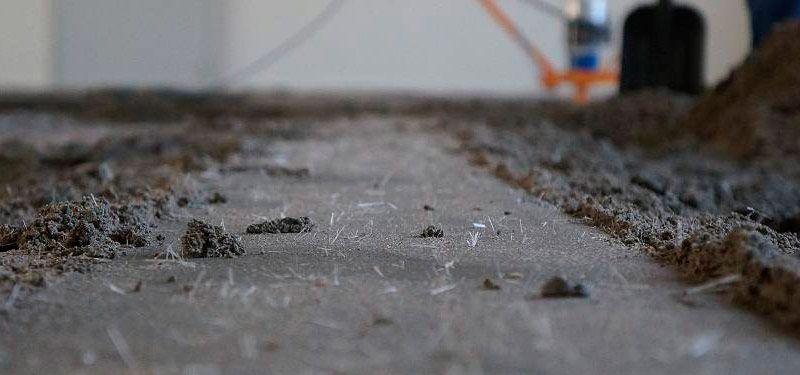
If there are pipelines, cables and other communications and structural elements in the screed array, its thickness must be such that the mortar covers the structures by at least 1 cm. This provides sufficient protection of the communications and adequate resistance of the screed structure to deforming influences, for example, when expanding pipes underfloor heating or thermal shifts as a result of heating with electric cables.
In the classic case, a semi-dry screed is a factory-made mixture that is fed to the place of use by special pumps through pipelines. The plasticity of the mass allows it to be raised to a height of 30 floors, which virtually removes the restrictions on use in high-rise construction. This is one of the main advantages - the mass is fed to the entire area at the same time, excluding its manual movement with buckets or stretchers.
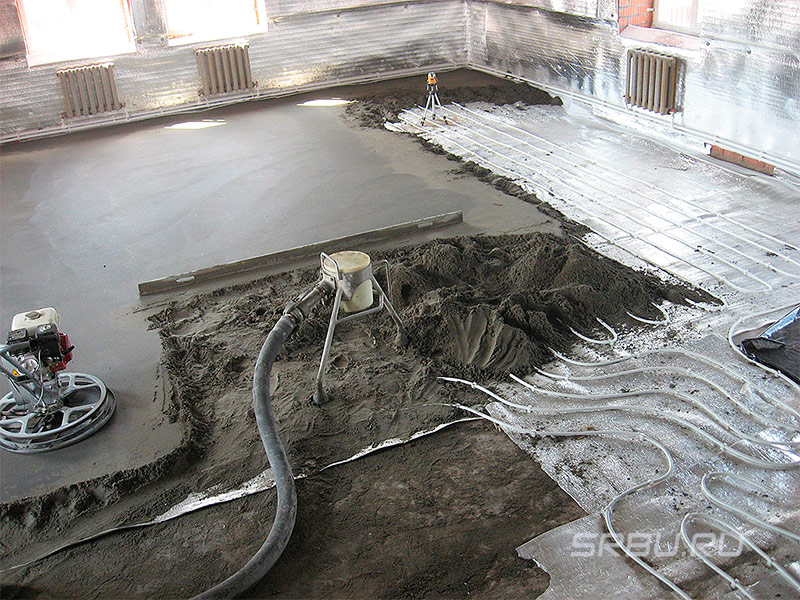
The plasticity of the composition facilitates leveling and grouting of the surface, and the presence of polymer fibers does not allow cracking. Accelerated drying, due to the reduced amount of water, allows you to carry out work quickly and begin to operate the surface much faster than with conventional methods of installing the base under the floors.
When preparing the mortar for screed, it must be taken into account that the presence of chlorine and fluorine in water significantly impairs the strength of the finished layer.Water should be taken not from the city water supply, but from natural reservoirs or deep wells, as, however, for the preparation of any other solution, the strength of which depends on the result of construction.
Pros of dry screed
The main positive aspects of a semi-dry screed are manifested during its industrial laying with the help of special equipment that allows you to feed the mixture through pipelines up to 200 m horizontally and up to 100 m in height. Smoothing and grouting the mixture is carried out immediately after filling the floor area and does not require a time interval for setting.
If we consider the obvious advantages of a semi-dry screed, then we can distinguish several main:
- The speed of arrangement of the screed;
- Surface quality;
- Lack of leaks;
- The possibility of arranging multilevel surfaces;
- High performance;
- High heat engineering and mechanical characteristics;
- Environmental properties;
- Cost.
Screed setting speed
Physico-chemical processes occurring inside the screed array are the same as in a normal solution. But there is not much moisture here - just enough so that all the cement molecules are hydrated and take part in the setting of the solution. Water practically does not evaporate from the surface - it is all involved in chemical bonds. This reduces the drying time for the screed - the surface can be used 12 hours after installation and leveling.
But flooring should be with some precautions. Although the moisture content of the screed is low, it contains enough water to create adverse conditions for wooden structures. Therefore, ceramic concrete, tiles, linoleum can be laid 2–3 days after finishing the floor with a semi-dry screed, but plank floors, parquet and laminate can be laid 10–14 days later, waiting until all the moisture has evaporated not only from the surface, but also from the volume of the screed.
Consider the fact that the layer thickness should be at least 5 cm. With a room area of 10 to 75 m2 although it contains a little moisture, it takes at least 10 to 14 days to remove it to a level that is safe for wood.
Surface quality
The consistency of the solution and the presence of fiber fibers in the composition eliminates the subsidence of the surface during drying, the formation of voids and caverns inside after evaporation of water (there is simply nothing to evaporate), the occurrence of cracks as a result of uneven drying. The use of grinders when grouting the surface of the screed additionally compacts the outer layer and the screed turns into an almost waterproof monolithic concrete.
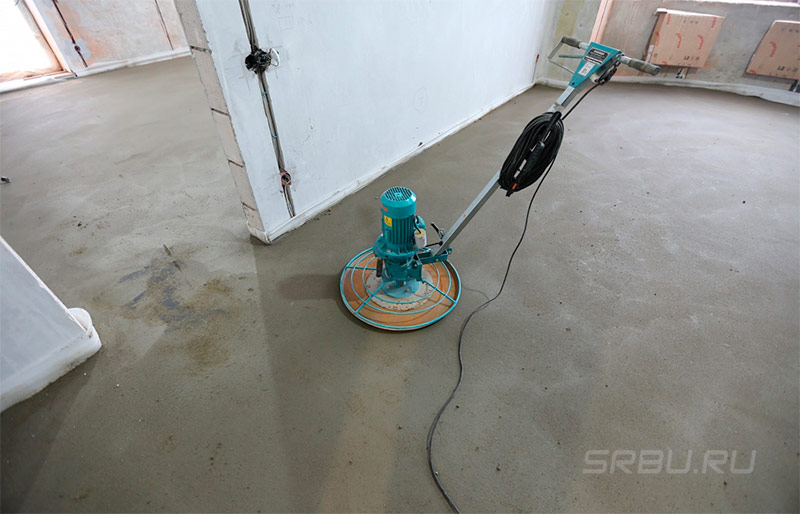
During the subsequent installation of bulk floors made of epoxy or polymeric materials, their consumption is significantly reduced - the porosity of the base is very low and the bulk mass practically does not penetrate into the screed. However, this does not affect the adhesion level - the coating adheres to a semi-dry screed is no worse than to a normal one.
Features of the material allow you to set it with high accuracy - after grinding, the deviations in height do not exceed 2 mm per linear meter of length. Given the high cost of the bulk floor, the reduction in material consumption leads to significant savings, which will exceed the cost of using special equipment.
Lack of leaks and cleanliness of work
Another positive side of using a semi-dry screed is its cleanliness. In addition to the absence of polluting sprays and streaks on the surface, a small amount of water in the mass prevents its flow through the joints of the floor panels to the lower floors. This makes it possible to use this screed option in case of repair, when the lower floors are already fully finished.
Compared with a completely dry screed, the risk of water entering the lower floors is somewhat greater. But the dry screed in its classic form is practically not used in industrial construction.The scope of its application is country and frame houses, low-rise wooden construction, cottages.
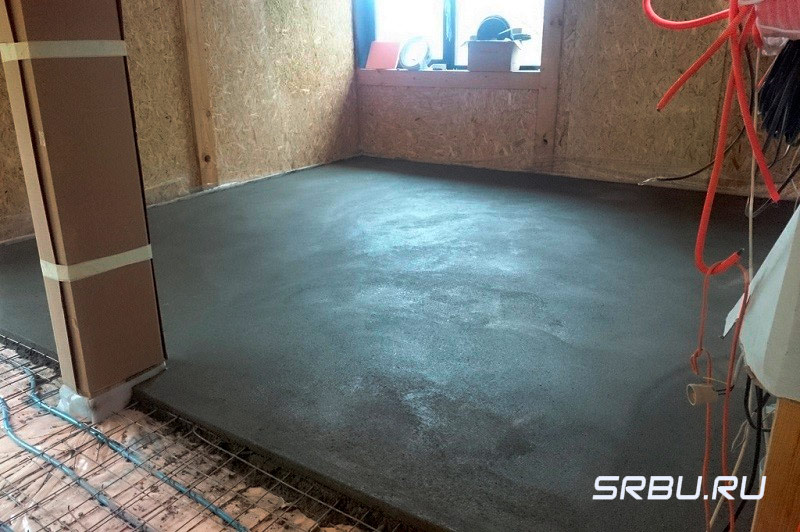
The possibility of arranging multilevel surfaces
Due to the plasticity and density of the mortar, as well as the ability to maintain a given shape, the semi-dry screed mounting method allows you to continuously perform the process when preparing the bases for different coatings. In the case of a liquid cement-sand mortar, such work at one time is much more difficult to perform - a significant time interval or the construction of formwork will be required, which in turn requires a time interval and additional costs for materials and payment for work.
High performance
Compared to other methods of leveling the foundations and preparing industrial floors, a semi-dry screed provides the highest productivity - up to 400 m2 finished cover per shift. This quality is especially valuable when installing the screed in large areas:
- hangars;
- trading floors;
- industrial workshops;
- garages;
- sports facilities;
- warehouses.
Mechanical supply of the finished solution of the same consistency and chemical composition allows you to not limit the maximum installation area of a semi-dry screed. This method is appreciated by large construction organizations, as it allows to reduce construction time.
High thermal and mechanical characteristics
The composition of the components of the semi-dry screed and a monolithic structure significantly increases the surface resistance to abrasion. Even when used as an industrial floor without coating, the surface does not dust and is not damaged when using warehouse or workshop equipment on pneumatic or plastic wheels.
When exposed to screed surfaces, the loads are distributed evenly and the entire structure of the room is less deformed. Some porosity of the screed mass also exerts lower loads on the underlying layers of the base or floor.
The porosity of the screed mass and the presence of mineral or polymer fibers increase the heat and sound insulation properties of the material. This saves on the use of additional sound absorbers and heat-shielding materials on the floors - their layer can be made thinner, or even eliminated. But the thermal properties do not preclude the use of semi-dry screeds as the basis for the installation of warm floors. A small layer of fiber-reinforced concrete on top of pipes or cables does not reduce the effectiveness of the heating system.
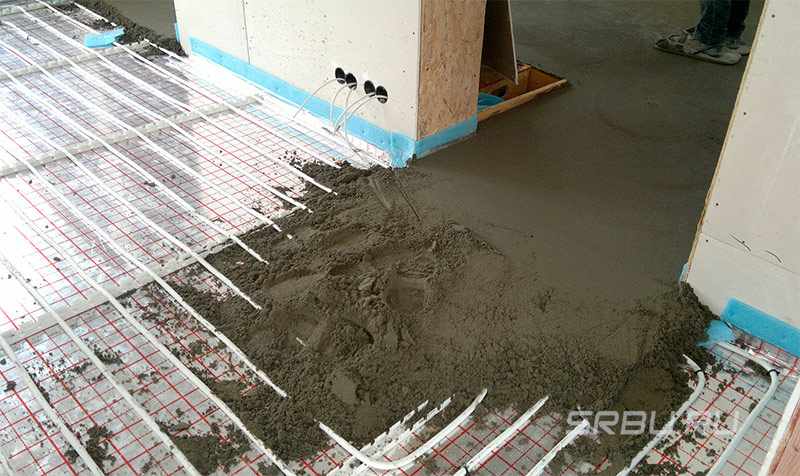
Environmental properties
In terms of ecology, a semi-dry screed should be considered both from the point of view of operation, and in the context of the construction process.
As already mentioned, the finished semi-dry screed:
- almost no dust,
- does not absorb moisture
- no noise
- It is very well cleaned and washed without abrasion even when using mildly active detergents and light abrasives.
When heated by direct sunlight, it does not deform, does not crack, and does not collapse. Semi-dry screed to low and high air temperatures is also indifferent. When heated, the material behaves akin to concrete, without emitting volatile compounds and allergens. Polymer and mineral fibers are firmly bound by cement and do not stand out in the form of dust even under strong mechanical stresses on the surface.
Construction work is also quite safe - the entire stage of preparation of the mixture takes place in a special closed container - a mixer. The supply is carried out by hermetic pipelines that do not affect the environment. When smoothing and grouting a wet surface, dust and splashes are not formed that can irritate the respiratory tract or mucous membranes of a person.
The cost of arranging a semi-dry screed
The cost of a semi-dry screed is lower than wet, and even more so - dry. The most tangible economic effect is manifested during its installation on areas of more than 100 m2. Such volumes allow you to maximize the use of equipment and reduce labor costs for the production of 1 m2 finished surface. With manual preparation of the mortar and laying without the use of special machines, the cost is almost equal to the usual, wet, but all the main advantages remain.
Cons dry screed
Along with the obvious advantages of a semi-dry screed, there are a number of minuses, which, for the most part, are objective and noticeable under all conditions of its use. These qualities:
- High cost with low volumes of use;
- Difficulties working at low temperatures;
- Poor fluidity;
- Fear of water;
- Thickness;
- Insufficient compaction.
High cost with low usage
One of the disadvantages is the rather high cost if the work is carried out in limited areas. For example, the cost of installing such a screed in a private house can be several times higher than wet, even with the independent preparation of the solution.
To prepare the solution, special sand is required, the deposits of which are quite rare. Sand delivery over long distances significantly increases the cost of the mixture, especially if it is required a little, of the order of 1.5 - 2 m3. But if the screed is installed over a large area, then the sand is delivered by heavy transport, which somewhat reduces its cost.
The same picture with cement - buying several bags of cement will cost more than a wholesale batch with delivery. It is difficult to prepare the necessary solution in place, for this it will be necessary to deliver the necessary equipment to the object. Equipment rental costs some money.
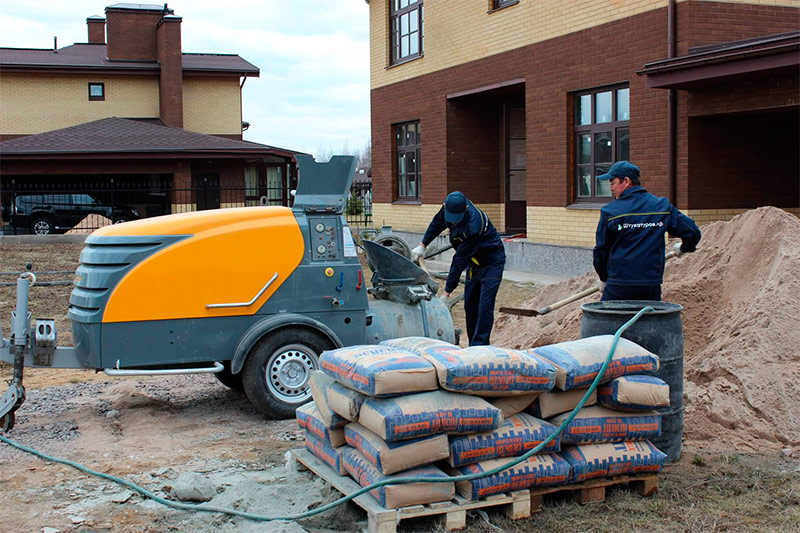
When installing the screed in a wet way, the costs are much lower - any sand is suitable, for the preparation of the mixture a simple concrete mixer is enough, there is no need to order pneumatic blower equipment. But again, this minus is noticeable when working on small areas or objects that are far from each other. In the industrial construction of a multi-story building or cottage village, these costs are leveled and the cost per square meter of screed is significantly reduced.
Low temperatures
The second minus when working with a semi-dry screed is associated with air temperature. It can only be mounted at a positive temperature or in heated rooms, the base for the screed in which is also quite warmed up. But here "pitfalls" await. All equipment for the preparation of the solution, as a rule, is located on the street.
At low temperatures, sand freezes into blocks and boulders, which are difficult to grind by hand. There are difficulties with the delivery of water. Although it does not require too much, it is still impossible to store it in tanks, and hoses and pipes freeze very quickly.
In conditions of large construction, the solution is quite simple - install the equipment in a heated temporary room heated by air guns. It is usually enough to warm the air inside to +5 - 7 0C so that you can prepare the solution without obstacles. In pipelines, it will not freeze in motion - the heat capacity of the cement-sand mixture is quite high and before it arrives at its destination, its temperature will have time to drop by only 1-3 degrees, which is not critical.
In large cities, when conducting construction under conditions of dense development, a new complexity arises - a lack of space for installing equipment and storing a large amount of raw materials. But with the proper organization of the construction site, this drawback is eliminated very simply. Perhaps a large number of options, it all depends on the specific conditions at the construction site and the ingenuity of engineers and foremen.
Low fluidity
One of the main disadvantages determined by the characteristics of the mixture is the lack of fluidity. If in the pipeline, the mass supplied under pressure flows quite tolerably and even sometimes behaves like a liquid, then in the free state it flows quite poorly.This causes difficulties with filling corners, lines of contact with columns, walls and racks.
To eliminate this drawback is also quite simple, but, like all additional actions and materials, it costs some money and increases the cost of the cost of one square meter, however, it is not critical. In order to increase the fluidity, plasticizers are added to the composition - special chemical reagents that practically do not affect the hydration process and do not reduce the strength of the finished coating. Plasticizers only slightly increase fluidity, which is usually quite enough for the solution to form as it should.
If this is not enough, at the initial stage of the solution supply, you can manually tamp the mass at the junctions. As a rule, the length of the contact lines with the wall is not too long, so the task is quite feasible and affects the cost of the screed and the speed of the work.
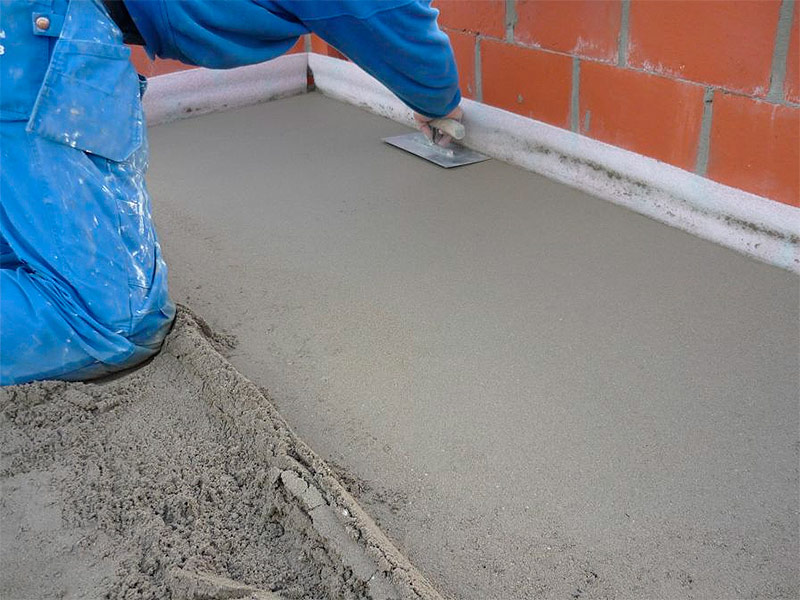
The only thing that is not recommended is to add water to the solution. In this case, the mass becomes too liquid and the screed in the wetting areas will have low strength.
Hydrophobicity
The next disadvantage is hydrophobia. Prior to complete drying, contact with water should be excluded completely and exposure to liquids should be limited during further operation. The fact is that the hydration process with a lack of water occurs slowly and not completely. There always remains a certain percentage of unreacted cement molecules that are ready to interact with water upon contact. As a result of this, the screed can crack and swell, which is undesirable until it is covered with paint or a bulk floor.
Thickness
Making a semi-dry screed less than 5 cm thick is not recommended. This is also associated with processes occurring within the mass. If the layer is too thin. That water evaporates faster than the setting of the solution takes place and it does not have time to stick to the base. As a result, delaminations are observed, often quite significant in area.
But even more than 7 cm, it is impractical to make the layer thickness due to the large weight of the material - a square meter screed 7 cm thick. Weighs more than 120 kg. Such loads on the floors are undesirable, a thicker layer can be done only on the ground or on a bulk base. Often, backfilling with expanded clay or pouring with expanded clay concrete under a semi-dry screed is also used on floors, if it is necessary to raise the floor.
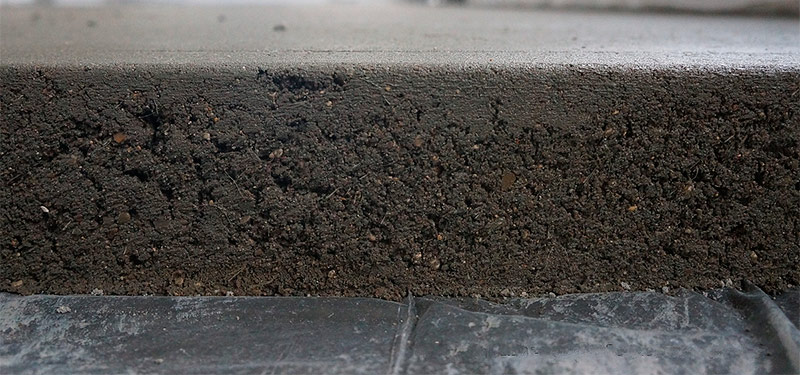
Insufficient seal
Often, the screed for various reasons is not compacted enough, which leads to partial destruction after installing the floor covering, the appearance of creaks and noises. To prevent this from happening, one should take full responsibility for smoothing and polishing the surface. Timely use of grinding machines will allow to compact the material to the required limit.
To exclude a greater number of undesirable phenomena, it is necessary to lay the screed strictly according to technology. The slightest deviation leads to cracking or peeling. Care should be taken to observe the proportions of the components, especially the amount of water. Excess moisture, as well as its lack, is equally undesirable. In the event of an excessive amount, the screed loses its density, becomes less durable and gives shrinkage and cracks. If there is little water, then hydration does not occur in full, which leads to the appearance of pores and caverns.
Part of the shortcomings that are often cited by opponents of a semi-dry screed are, in fact, not flaws. An example is heterogeneous density - the base of the screed is more loose than the upper part. The density gradually increases from bottom to top due to the low fluidity of the material. The average density of the dried screed is up to 1800 kg / m3, which is slightly lower than that of liquid concrete (sand / cement, without mineral fillers).
In studies, the fracture strength of the control cube of a semi-dry screed is up to 150 kg / cm2, which corresponds to concrete М150, recommended for the equipment of bases for floors.
Regarding reproaches that a semi-dry screed forms an uneven surface that must be leveled with a bulk floor, this is not entirely correct.If you use beacons and serviceable grinders, then any floor covering can be laid without leveling in bulk. In the general case, so that after laying a semi-dry screed only its positive qualities are manifested, high-quality materials should be used and the technology requirements must be strictly observed.
It should also be noted that any of the construction technologies, including the most innovative ones, does not consist of only advantages. You can always find something that does not suit you and is not suitable for a specific application. It is knowledge of all the positive and negative qualities that allows you to choose options for a particular construction method, in this case, the installation of screed.

